Abstract
Premature lambs were treated with 50 mg/kg of natural surfactant lipid by tracheal instillation either at birth or shortly thereafter when respiratory failure was documented. All lambs were delivered by cesarean section and supported on infant ventilators with 100% oxygen under conditions to mimic the care of human infants with the respiratory distress syndrome. The natural surfactant used for therapy was recovered by lavage from sheep lung. Six 120-d gestational age lambs treated at birth had an initial mean oxygen pressure (pO2) value of 270 +/- 35 mm Hg; this fell within 3 h to less than 100 mm Hg. By 8.3 +/- 0.3 h after birth the lambs were in severe respiratory failure with a mean pH less than 7.1 and a mean pCO2 greater than 70 mm Hg. Six untreated lambs had pH values below 7.0 within 40 min of life despite more intensive respiratory support than was given the treated animals. Treatment with natural surfactant of 17 lambs of 120 and 130 d gestational age after early respiratory failure resulted in a prompt increase in pO2 values from about 35 mm Hg to values over 200 mm Hg and a fall in pCO2 values to normal levels in the majority of animals. This response lasted only approximately 3 h, and a second treatment was less predictably effective.
Full text
PDF
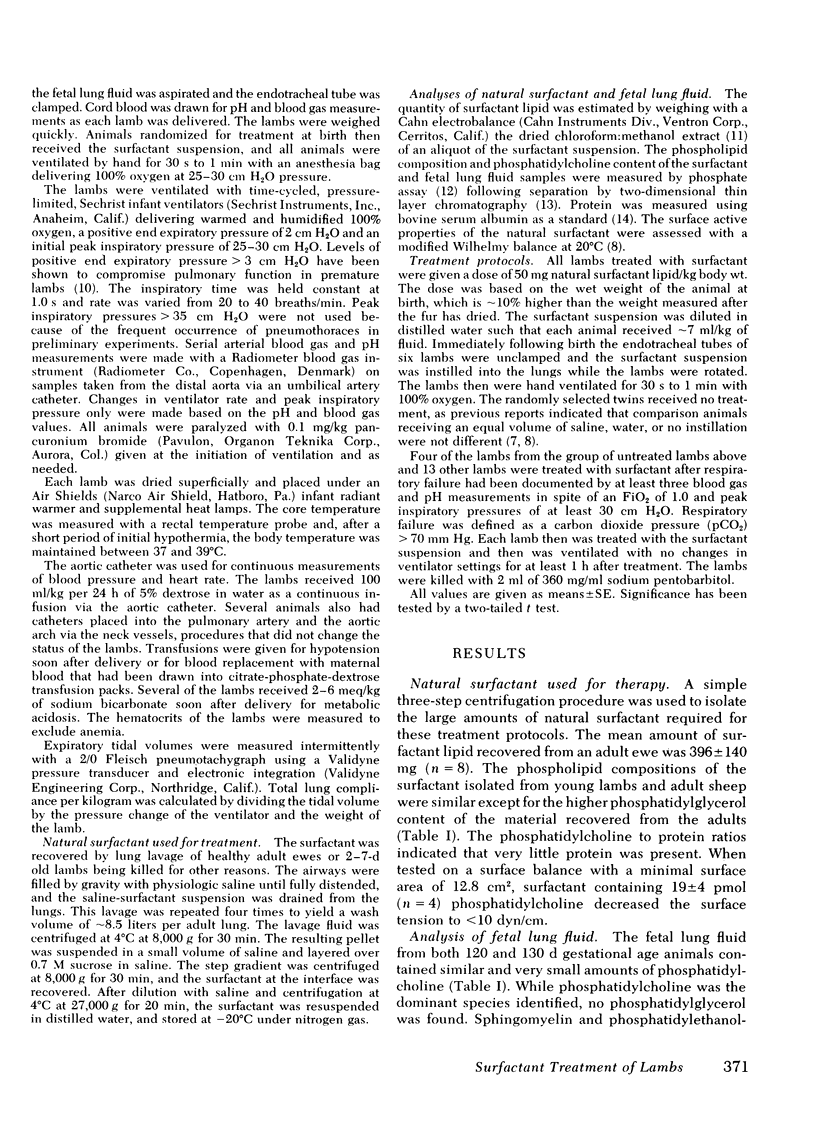
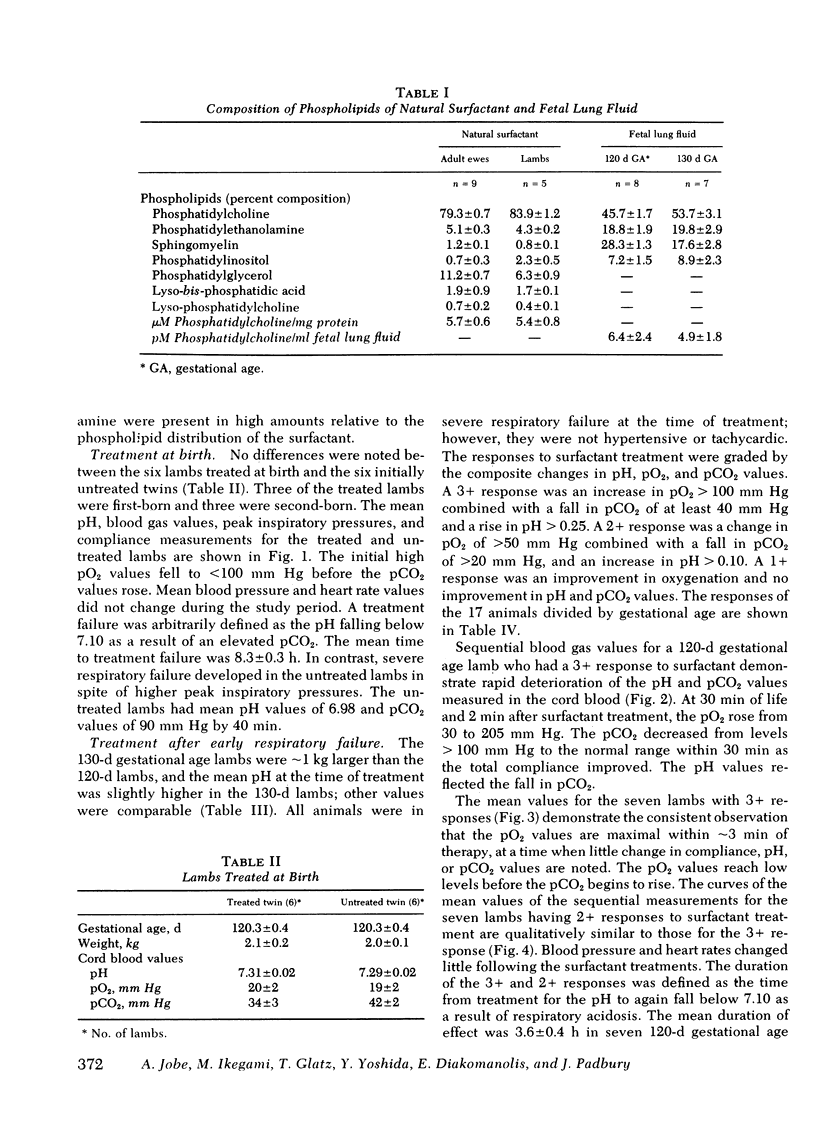
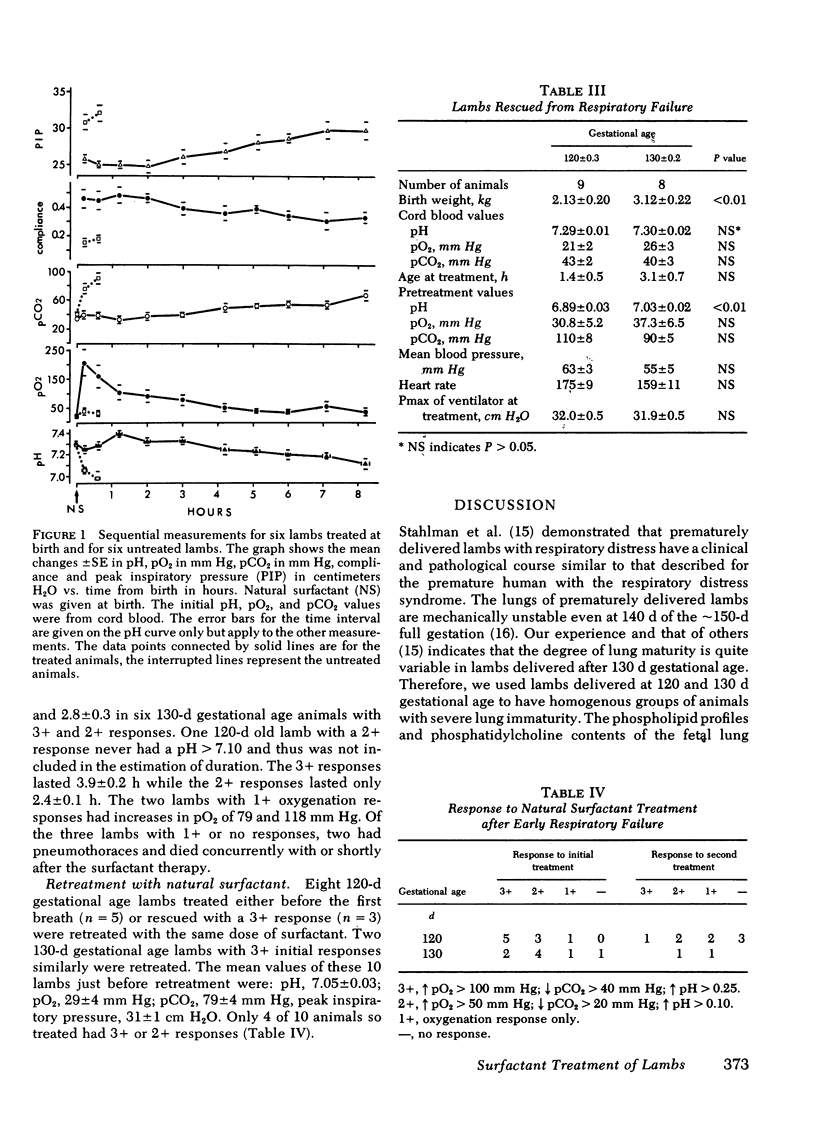
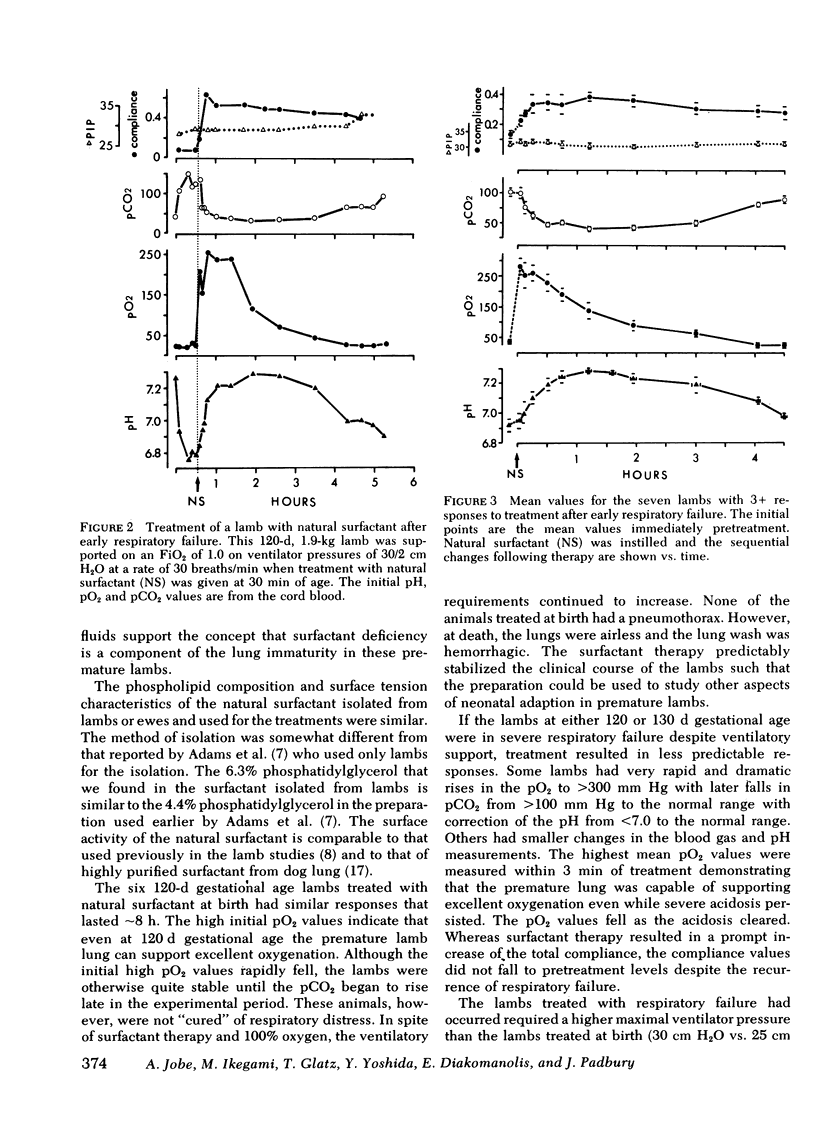
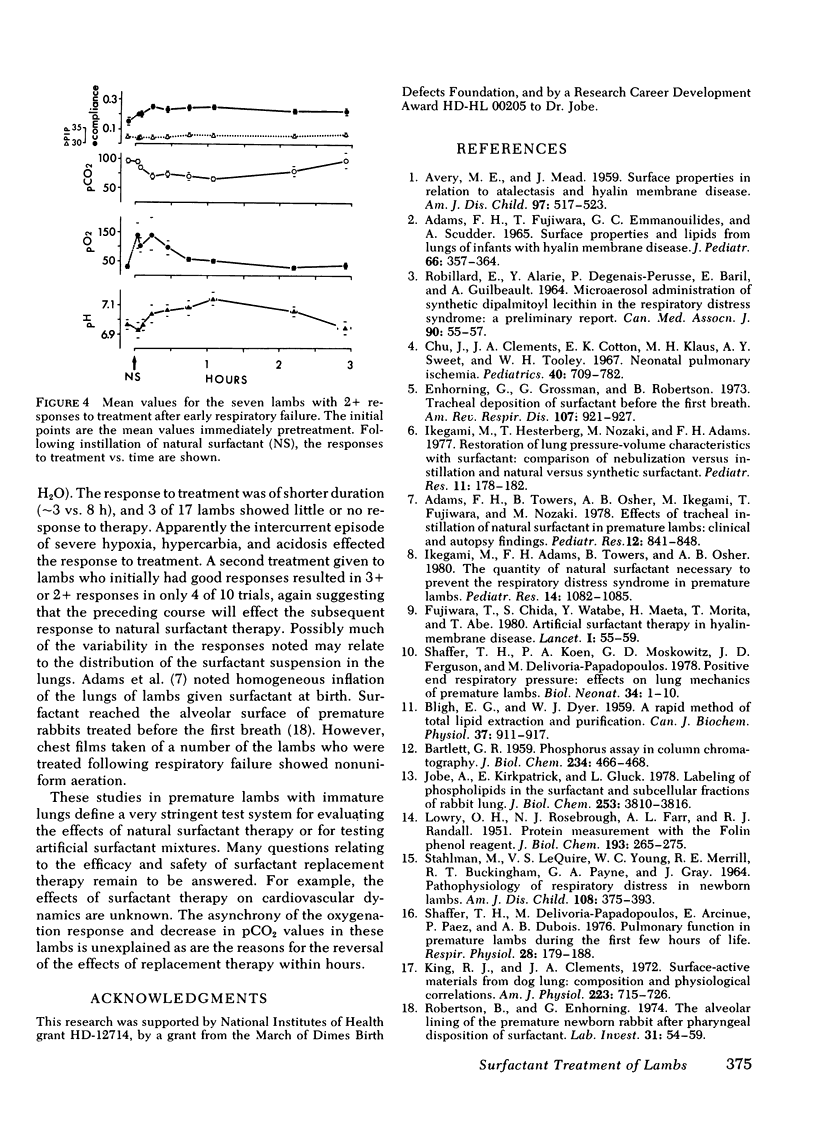
Selected References
These references are in PubMed. This may not be the complete list of references from this article.
- ADAMS F. H., FUJIWARA T., EMMANOUILIDES G., SCUDDER A. SURFACE PROPERTIES AND LIPIDS FROM LUNGS OF INFANTS WITH HYALINE MEMBRANE DISEASE. J Pediatr. 1965 Feb;66:357–364. doi: 10.1016/s0022-3476(65)80193-7. [DOI] [PubMed] [Google Scholar]
- AVERY M. E., MEAD J. Surface properties in relation to atelectasis and hyaline membrane disease. AMA J Dis Child. 1959 May;97(5 Pt 1):517–523. doi: 10.1001/archpedi.1959.02070010519001. [DOI] [PubMed] [Google Scholar]
- Adams F. H., Towers B., Osher A. B., Ikegami M., Fujiwara T., Nozaki M. Effects of tracheal instillation of natural surfactant in premature lambs. I. Clinical and autopsy findings. Pediatr Res. 1978 Aug;12(8):841–848. doi: 10.1203/00006450-197808000-00008. [DOI] [PubMed] [Google Scholar]
- BARTLETT G. R. Phosphorus assay in column chromatography. J Biol Chem. 1959 Mar;234(3):466–468. [PubMed] [Google Scholar]
- BLIGH E. G., DYER W. J. A rapid method of total lipid extraction and purification. Can J Biochem Physiol. 1959 Aug;37(8):911–917. doi: 10.1139/o59-099. [DOI] [PubMed] [Google Scholar]
- Chu J., Clements J. A., Cotton E. K., Klaus M. H., Sweet A. Y., Tooley W. H., Bradley B. L., Brandorff L. C. Neonatal pulmonary ischemia. I. Clinical and physiological studies. Pediatrics. 1967 Oct;40(4 Suppl):709–782. [PubMed] [Google Scholar]
- Enhörning G., Grossman G., Robertson B. Tracheal deposition of surfactant before the first breath. Am Rev Respir Dis. 1973 Jun;107(6):921–927. doi: 10.1164/arrd.1973.107.6.921. [DOI] [PubMed] [Google Scholar]
- Fujiwara T., Maeta H., Chida S., Morita T., Watabe Y., Abe T. Artificial surfactant therapy in hyaline-membrane disease. Lancet. 1980 Jan 12;1(8159):55–59. doi: 10.1016/s0140-6736(80)90489-4. [DOI] [PubMed] [Google Scholar]
- Ikegami M., Adams F. H., Towers B., Osher A. B. The quantity of natural surfactant necessary to prevent the respiratory distress syndrome in premature lambs. Pediatr Res. 1980 Sep;14(9):1082–1085. doi: 10.1203/00006450-198009000-00013. [DOI] [PubMed] [Google Scholar]
- Ikegami M., Hesterberg T., Nozaki M., Adams F. H. Restoration of lung pressure-volume characteristics with surfactant: comparison of nebulization versus instillation and natural versus synthetic surfactant. Pediatr Res. 1977 Mar;11(3 Pt 1):178–182. doi: 10.1203/00006450-197703000-00007. [DOI] [PubMed] [Google Scholar]
- Jobe A., Kirkpatrick E., Gluck L. Labeling of phospholipids in the surfactant and subcellular fractions of rabbit lung. J Biol Chem. 1978 Jun 10;253(11):3810–3816. [PubMed] [Google Scholar]
- King R. J., Clements J. A. Surface active materials from dog lung. II. Composition and physiological correlations. Am J Physiol. 1972 Sep;223(3):715–726. doi: 10.1152/ajplegacy.1972.223.3.715. [DOI] [PubMed] [Google Scholar]
- LOWRY O. H., ROSEBROUGH N. J., FARR A. L., RANDALL R. J. Protein measurement with the Folin phenol reagent. J Biol Chem. 1951 Nov;193(1):265–275. [PubMed] [Google Scholar]
- ROBILLARD E., ALARIE Y., DAGENAIS-PERUSSE P., BARIL E., GUILBEAULT A. MICROAEROSOL ADMINISTRATION OF SYNTHETIC BETA-GAMMA-DIPALMITOYL-L-ALPHA-LECITHIN IN THE RESPIRATORY DISTRESS SYNDOME: A PRELIMINARY REPORT. Can Med Assoc J. 1964 Jan 11;90:55–57. [PMC free article] [PubMed] [Google Scholar]
- Robertson B., Enhorning G. The alveolar lining of the premature newborn rabbit after pharyngeal deposition of surfactant. Lab Invest. 1974 Jul;31(1):54–59. [PubMed] [Google Scholar]
- STAHLMAN M., LEQUIRE V. S., YOUNG W. C., MERRILL R. E., BIRMINGHAM R. T., PAYNE G. A., GRAY J. PATHOPHYSIOLOGY OF RESPIRATORY DISTRESS IN NEWBORN LAMBS. CIRCULATORY, BIOCHEMICAL, AND PATHOLOGICAL CONSIDERATIONS. Am J Dis Child. 1964 Oct;108:375–393. doi: 10.1001/archpedi.1964.02090010377008. [DOI] [PubMed] [Google Scholar]
- Shaffer T. H., Delivoria-Papadopoulos M., Arcinue E., Paez P., Dubois A. B. Pulmonary function in premature lambs during the first few hours of life. Respir Physiol. 1976 Nov;28(2):179–188. doi: 10.1016/0034-5687(76)90037-2. [DOI] [PubMed] [Google Scholar]
- Shaffer T. H., Koen P. A., Moskowitz G. D., Ferguson J. D., Delivoria-Papadopoulos M. Positive end expiratory pressure: effects on lung mechanics of premature lambs. Biol Neonate. 1978;34(1-2):1–10. doi: 10.1159/000241098. [DOI] [PubMed] [Google Scholar]


